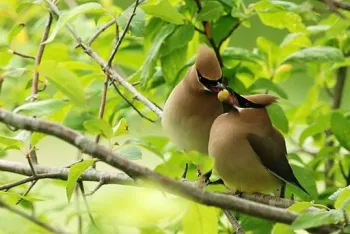
Mistletoe are plants that grow on the branches of trees or large shrubs. Because they are largely parasitic, they tend to have a mixed reputation. But there's more to the story of mistletoe. . .
Mistletoe Folklore
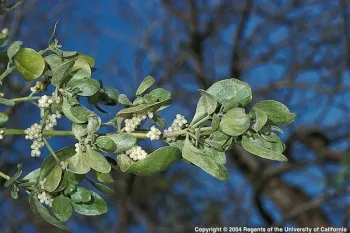
Mistletoe legends go back hundreds of years. It was considered a symbol of life because when other plants are leafless in winter, it is green and bears fruit.
An old Norse legend says the god Balder was mistakenly killed by a blind brother with an arrow of mistletoe. His mother's tears turned into white berries as they fell on mistletoe, so the plant became associated with undying love.
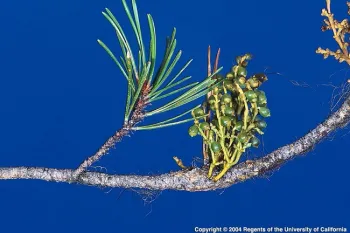
The ancient Celts used mistletoe as part of their winter solstice celebrations. Druids considered mistletoe to be a sacred plant because it didn't grow from roots, but on branches high up in trees. People would wear mistletoe charms for good luck and protection from evil spirits. Sprays would be hung from doorways to ensure only happiness could enter a home.
By the 1700's, “kissing balls” made of holly, boxwood and mistletoe were hung in windows and doorways during the winter holidays. A young lady caught under one could not refuse a kiss. According to custom, after each kiss, a berry would be removed, until they were all gone.
What is Mistletoe?
Mistletoe ”kisses” a tree or shrub by attaching to a branch using a connective appendage through which it sucks water and nutrients from its host. Mistletoe is either female or male. Males produce only pollen. The female plants produce sticky white berries from October – December.
The two most common species found in our area are:
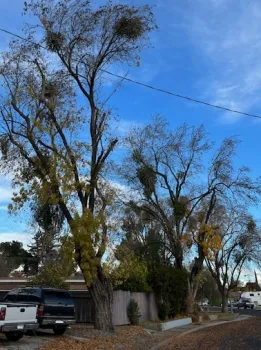
Broadleaf mistletoe (Phoradendron macrophyllum) grows on several landscape trees including alder, flowering pear, box elder, silver maple, zelkova, and walnut. Some broadleaf mistletoe species also conduct photosynthesis so are hemiparasite (half-parasite). The sticky berries are eaten by cedar waxwings, robins and other birds. The birds digest the seeds, excreting living seeds which stick to a branch they may land on. Infestations tend to occur on taller, mature trees, because birds prefer higher perches.
Dwarf mistletoe (Arceuthobium spp.) infest pines, firs, junipers, and other conifers. They are true parasites, obtaining all their nutrients from their host plant. Due to conifers being evergreen year-round, the small size, and inconspicuous coloration of dwarf mistletoe, they can be difficult to spot. Dwarf mistletoe seeds are spread mostly by forcible ejection, which can propel sticky seeds onto needles of nearby conifers up to 40 feet away. When it rains, the seeds slide down the needles to twigs where infestation occurs. More common in the Sierra foothills, dwarf mistletoe is not found as often in urban/suburban environments.
Mistletoe Myth
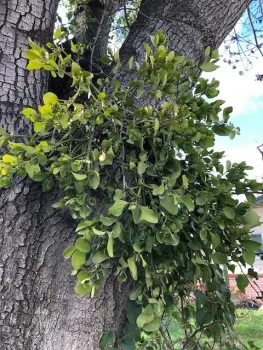
While mistletoe is largely parasitic, it is a myth that they always kill their host plant and should be removed if it appears in your tree. Mistletoe rarely kills a healthy tree, though it may lose some branches due to infestation.
Broadleaf mistletoe has been shown to have several important benefits for nature. They provide food for wildlife (birds love the berries!), as well as cover and nesting sites for birds and some small mammals. In some instances, they have been associated with increased biodiversity.
Mistletoe Infestations
The most effective control is to remove infected branches as soon as they become apparent, after leaves drop in autumn, by pruning at least one foot from the point of mistletoe attachment. Chemicals only provide short-term control and don't kill mistletoe plants. Since broadleaf mistletoes easily spread from tree to tree in urban/suburban settings due to birds, a community cooperative effort is the best defense by removing all mistletoes from all streets. See UC IPM Pest Notes for more detailed information: https://ipm.ucanr.edu/legacy_assets/PDF/PESTNOTES/pnmistletoe.pdf
Planting tree species which appear to be resistant to mistletoes can help reduce future infestations. Mistletoe rarely infest Bradford flowering pear, Chinese pistache, crape myrtle, ginkgo, liquid amber, sycamore, true cedars or redwood. Susceptible tree varieties include alder, Modesto ash, and Aristocrat flowering pear. Most dwarf mistletoe attack only a few related pine species, so replanting with a diversity of trees will help.
Enjoy Mistletoe!

In cases when there is little concern that mistletoes will spread to other trees (because area trees are healthy and/or already resistant) take pleasure in seeing the occasional cluster of broadleaf mistletoes hanging high on branches of bare trees in the winter. After all, a flock of cedar waxwings descending on a tree with mistletoe berries is a sight to see! And, without mistletoe, we can't have bunches of decorative balls of mistletoe hanging in our homes so people can stand under them during the winter holidays and be kissed!
Resources
UC IPM Quick Tips: Mistletoes - https://ipm.ucanr.edu/legacy_assets/PDF/QT/qtmistletoe.pdf
UC ANR Blog, SJ County Master Gardener: Managing Mistletoe in Trees: https://ucanr.edu/blogs/blogcore/postdetail.cfm?postnum=26219
Denise Godbout-Avant has been a UC Master Gardener in Stanislaus County since 2020

